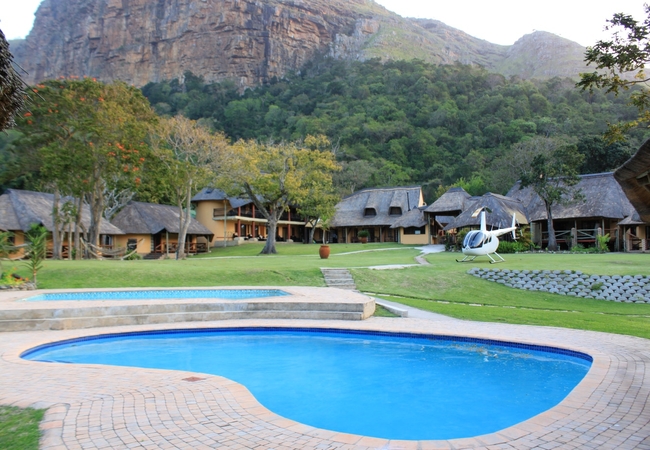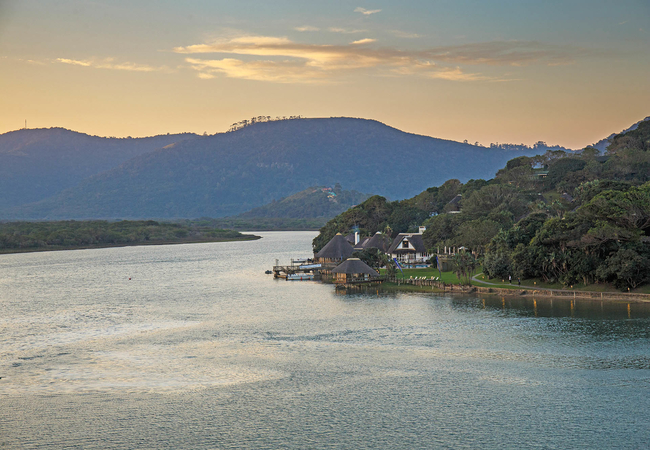Port St Johns, Wild Coast
The wildness of the coast with its deep gorges and impenetrable forests, mangrove swamps and the primitive force of freak waves that caused many a shipwreck along this region of the coast, have not quite managed the attempt to tame them by colonial order, since Port St Johns inception in 1878.
The setting of Port St Johns is possibly the most dramatic in the country and the drive from Umtata to Port St Johns is one of the best journeys on the Wild Coast. The Umzimvubu River cuts a huge gorge right to the sea where it then squeezes between the river's edge and the red stone cliffs of the gorge. Twin mountains, the Thesiger and Sullivan, lie on either side of the river mouth like bastions and are regarded as the gates of Port St Johns, which, despite this splendour, is largely a magnet for hippies, eccentrics and backpackers. Three good beaches, excellent fishing and a rather chequered history, involving the growing of cannabis instead of tobacco, might account for this.
Port St Johns also offers a unique blend of cultural richness. The Xhosa culture, both traditional and modern, is always apparent. You will see a sangoma (traditional healer) strolling along in all his finery, hear the thumping sound of kwaito music from a furniture store, and dodge the ever-present voracious mini-bus taxies.
This vibrant noise and colour is contrasted with some crumbling reminders of a colonial history. In the streets you will hear Xhosa, Afrikaans and English as well as foreign languages from the steady stream of tourists seeking the unusual. Dense bush encroaches into the town at any opportunity and a short walk will take you into silent forests. The sea is always close, crashing onto the rocky shores which guard the secluded beaches.
There is some debate over the origin of the town's name. Some attribute it to the Portuguese wreckage of the Sao Joao said to have run aground near the mouth of the Umzimvubu River in 1552 but it was then discovered to have settled further north up the coast near Port Edward. Others say that you can see the profile of John the Baptist carved in cliffs close to the river.
The river mouth was known for a while as Rosebud Bay and the estuary was a convenient venue for trading and smuggling until the British annexed the area. The lazy charm of the decaying colonial grandeur in the town belies the organised tourist infrastructure that provides accommodation, restaurants and craft shops.
This is prime hiking country, with forests and trails and more than 250 species of birds. Other activities in the area include: canoe trips, horse trails, golf, dolphin and whale watching and some excellent fishing.
Wish you were here?

Travellers' Reviews
4 Reviews from SA-Venues.com travellers. All reviews are verified.
Verified review
We always have a wonderful time in Port St Johns. We go every year.
April & Cliff (Bloemfontein)
Verified review
There are a number of ways to arrive in Port St Johns. The 133 bends in the road from Lusikisiki is a popular choice. However, walking from Port Edward along the beach, hills and cliffs is definitely the best way. It’s quite easy actually – all you do is go down to the beach at the Wildcoast Casino and keep walking. It’s a natural extension of the KZN South Coast. Walking gives one a unique perspective – a sense of place which is not achievable when driving through or flying over. Communities have opened their homes to overnight guests. Rondavels provide comfortable accommodation, and meals are feasts of traditional delights like steamed bread, sweet potatoes, samp and beans, fresh fish and imifino(greens). Water conservation is a way of life when buckets have to be carried up steep hills. Bathing in just a few litres of steamy water is perfectly possible and quite enjoyable too. Sitting under the stars around mielie cob fires inspires storytelling - the most interesting way to learn about culture. Local guides share stories of curious river names, astonishing shipwreck survivors, traditional uses of plants and local customs. It is ground up tourism, with passionate locals driving the process. “No more going away as migrant workers” says guide Vuyani Mbuzwa. “Home is best, I feel proud of my community and our environment.” The amaMpondo people have inhabited the area for centuries, generally living simple, satisfying lives in harmony with their environment. The Pondoland Centre of Endemism is a biodiversity hotspot. Over 2000 plant species occur there, with almost 200 found nowhere else on the planet. Conserving biodiversity (the variety of species) is critical for sustaining human existence. Besides the plants and animals, the area is famed for beautiful river estuaries with fabulous names: the Umtamvuna, the Mzamba, the Nyameni, the Mtentu, the Mzikaba, the Mkweni, the Lupatana, the Mlambomkulu, the Khutweni, Ntafufu and the Mkosi. Astonishingly, the water in most of the rivers can still be safely drunk. The coastal rock formations provide perfect places to climb into caves, view spectacular waves crashing on the shore and waterfalls cascading straight into the sea. After many days strolling along the sand or across the hillsides, stopping often to photograph flowers, dip in the ocean and to admire the views, we rounded the Poenskop corner and saw Port St John’s in the distance. We were rowed with gusto in a rickety boat crammed with passengers, across the uMzimvubu. From the middle of the river, we spotted a welcoming looking deck on the other side. Turned out to be the Fish Eagle Cafe, so we ordered cold beer and pizza straight from their oven and felt lucky, very lucky indeed, to have enjoyed such gracious hospitality in Pondoland. Rod Haestier from The Creek kindly fetched us. He also made us delicious vegetable curry for supper after we had indulged in hot baths and clean clothes. In the morning, he fired up his boat “Knuckle Cracker” and took us out to sea to see the dolphins. What an experience – the wind in our hair and spray on our faces, with the waves full of fins and tails. Afterwards, we relaxed over breakfast at the enchanting Delicious Monster Café on Second Beach, watching the cows on the sand. A quick stop at the Flee Market provided ample opportunity to do a little shopping - for beads and bags, local vegetables and preserves too. The busy Spar provided packets of local Majola tea to savour once we got home with our memories of the very nicest way to get to PSJ – by simply wandering South.
Nikki Brighton (Dargle)
In the vicinity
Hotels & other accommodation options

N'taba River Lodge
Set in amazing tropical gardens on the banks of the Umzimvubu River, N'taba River Lodge is a family resort offering the finest of Wild Coast hosp...

Port St Johns River Lodge
Situated on the mighty Umzimvubu River, Port St. John's River Lodge provides luxury accommodation with personal attention to detail and mouth wat...

Umngazi Hotel & Spa
The Wild Coast may be South Africa's most spectacular and yet least touristy region with its rocky coastline, indigenous forests, secluded coves ...
Things to do in the area

Cape Hermes Lighthouse
Even lighthouses have a dream of having their own sea-side patch of grass on the perfect hillside bordered by a little wooden picket fence. The b...

Dolphin and Whale Watching
Rod Hastier has worked for the Natal Sharks Board for many years and will teach you amazing things about sharks and dolphins. He is an excellent...

Hike to Eagles Nest
This is the sharp point of cliff rearing itself up from the forest edging the town entrance. The path is well defined and starts at a sign-post ...

Hiking in Silaka Nature Reserve
Silaka Nature Reserve lies on the south side of Second Beach. Park your car at the Office and take the trail along the coastline either north tow...

Umgazana Canoe Trails
Enjoy an early morning or afternoon canoe down the river. The Umngazana River hosts one of the largest Red Mangrove rich in birdlife. Soak up the...

M'bashe Lighthouse
The M'bashe lighthouse lies on the wild coast, part way between East London and Port St Johns and just down the road from a little holiday resort...

Pondo-Explore Hiking Trail
Start: MsikabaFinish: Mbotyi or Port St JohnsDuration: 3-5 nights; 45-68 kmFitness: the first couple of days the gradient is easy but you need a ...

Hiking Port St Johns To Coffee Bay
The Wild Coast is, undeniably, one of the world's most spectacular areas. The best way to experience its raw, unspoilt beauty is to explore it le...

Whale Watching In Bluewater Bay
Between July and December of every year, the Eastern Cape coastline is frequented by Southern Right Whales and Humpback Whales. These animals gli...
Noteworthy attractions

Wild Coast Sun Country Club
The Wild Coast Sun Country Club is a rugged beauty of a course. Carts are compulsory but this does not detract from the competitive challenge. Th...

Hole In The Wall
The Hole in the Wall at Coffee Bay is a unique structure with a huge detached cliff that has a giant opening carved through its centre by the wav...

Wild Coast Sun Golf Course
A memorable golf course situated on the magnificent Wild Coast. World-renowned golf course architect, Robert Trent Jones, has used the dramatic c...

Nelson Mandela Museum
The Museum offers visitors an inspiring journey through the life of Nelson Mandela. Known affectionately as 'Madiba', he is loved and respected w...

Silaka Nature Reserve
The Silaka Nature Reserve serves to protect the biodiversity of the coastal forest in the region, and stretches along the coastline between Secon...

Dwesa Cwebe Nature Reserves
The two fairly small sister nature reserves of Dwesa and Cwebe lie separated only by the Mbashe River on the central wild coast, bordered on one ...

Hluleka Nature Reserve
The virtually undiscovered Hluleka Nature Reserve lies roughly 20 kilometres south of Port St Johns on South Africa's Wild Coast, a part of the w...

Luchaba Nature Reserve
Close to the town of Umtata, now known as Mthatha, lies the charming 460 hectare nature reserve of Luchaba. Luchaba Nature Reserve lies adjacent ...

Magwa Waterfall
The Magwa waterfall is pretty impressive. It is one of few waterfalls on the rugged Wild Coast that is accessible – others entail such effort to ...
Find accommodation in Port St Johns
FIND / South Africa Accommodation / Eastern Cape Accommodation / Wild Coast Accommodation / Port St Johns Accommodation








